Petral Ltd: Analysis of Costing Methods for Products W and Z-2018
VerifiedAdded on 2023/06/14
|5
|1272
|147
Report
AI Summary
This report analyzes Petral Ltd's overhead allocation using both traditional and activity-based costing (ABC) methods. The traditional method calculates a plant-wide overhead rate based on total machine hours, while ABC allocates overheads based on specific activities and their respective drivers. The analysis reveals significant differences in overhead allocation between the two methods, particularly for Products W and Z. Under the traditional method, overheads are under-applied to Product W and over-applied to Product Z. ABC provides a more accurate picture of overhead costs by considering the specific activities that drive those costs, such as machine hours, set-up costs, material handling, and spare parts administration. The report concludes that ABC is a more realistic and reliable method for overhead allocation, as it reflects the true nature of overhead costs and provides a more accurate cost picture for each product. Desklib provides access to solved assignments and study tools to help students understand these concepts better.
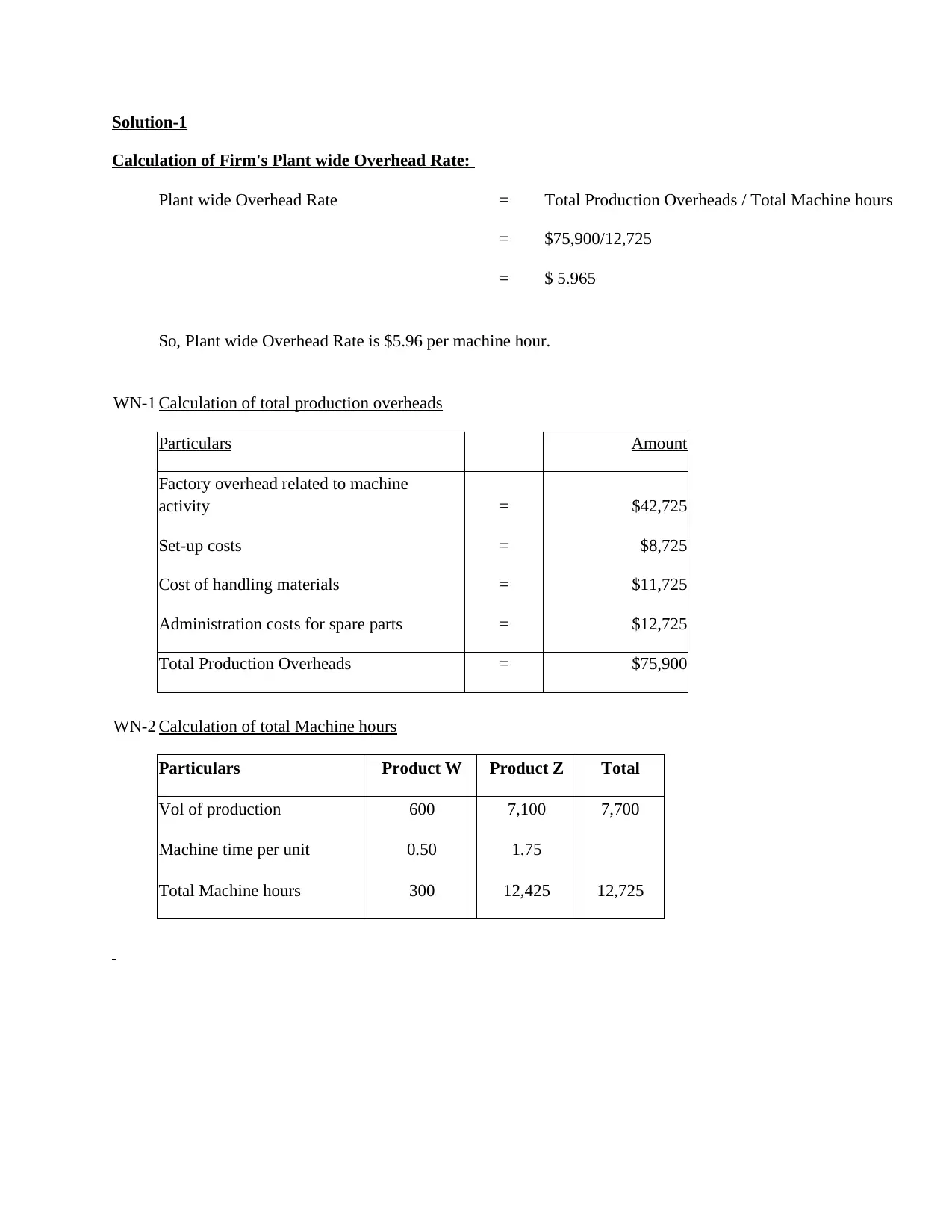
Solution-1
Calculation of Firm's Plant wide Overhead Rate:
Plant wide Overhead Rate = Total Production Overheads / Total Machine hours
= $75,900/12,725
= $ 5.965
So, Plant wide Overhead Rate is $5.96 per machine hour.
WN-1 Calculation of total production overheads
Particulars Amount
Factory overhead related to machine
activity = $42,725
Set-up costs = $8,725
Cost of handling materials = $11,725
Administration costs for spare parts = $12,725
Total Production Overheads = $75,900
WN-2 Calculation of total Machine hours
Particulars Product W Product Z Total
Vol of production 600 7,100 7,700
Machine time per unit 0.50 1.75
Total Machine hours 300 12,425 12,725
Calculation of Firm's Plant wide Overhead Rate:
Plant wide Overhead Rate = Total Production Overheads / Total Machine hours
= $75,900/12,725
= $ 5.965
So, Plant wide Overhead Rate is $5.96 per machine hour.
WN-1 Calculation of total production overheads
Particulars Amount
Factory overhead related to machine
activity = $42,725
Set-up costs = $8,725
Cost of handling materials = $11,725
Administration costs for spare parts = $12,725
Total Production Overheads = $75,900
WN-2 Calculation of total Machine hours
Particulars Product W Product Z Total
Vol of production 600 7,100 7,700
Machine time per unit 0.50 1.75
Total Machine hours 300 12,425 12,725
Paraphrase This Document
Need a fresh take? Get an instant paraphrase of this document with our AI Paraphraser
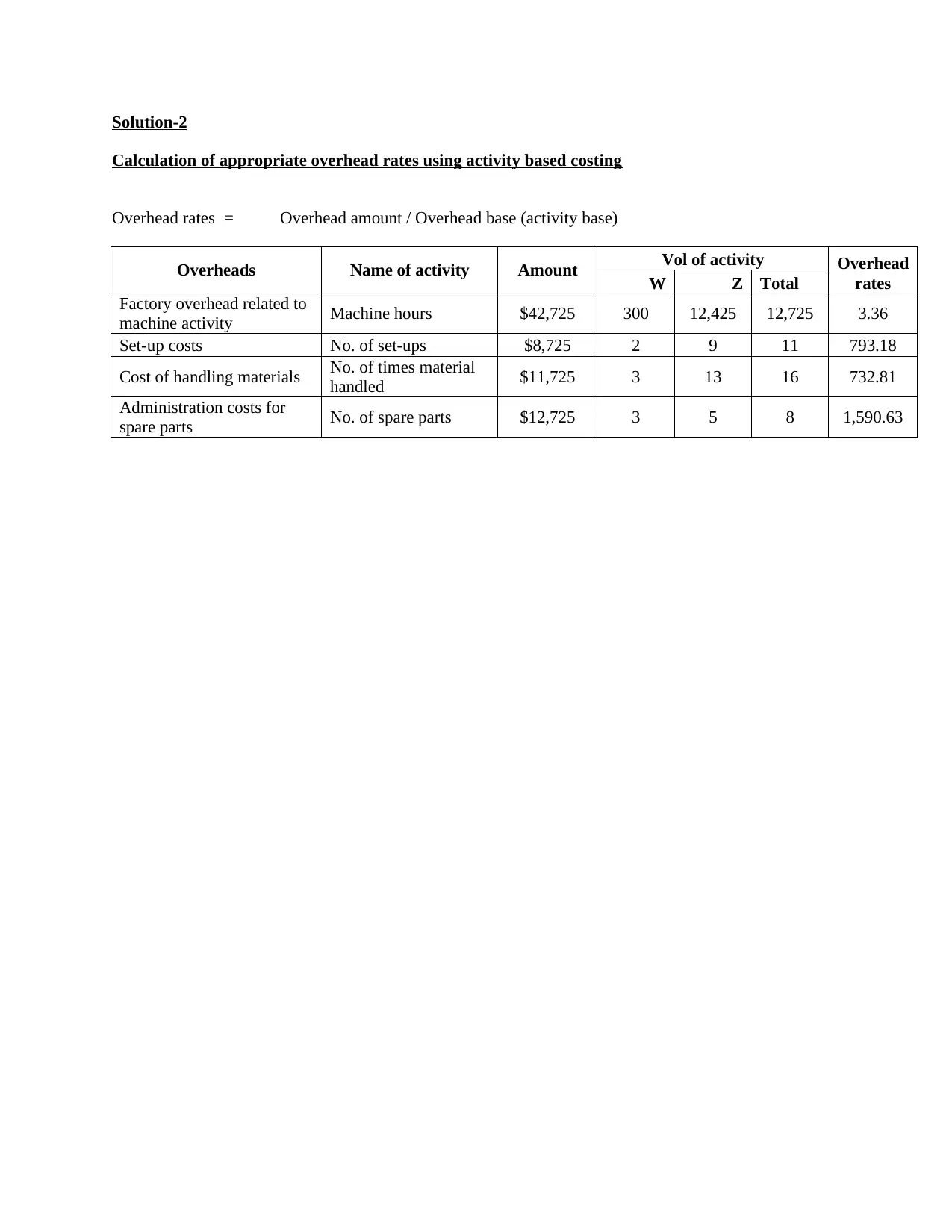
Solution-2
Calculation of appropriate overhead rates using activity based costing
Overhead rates = Overhead amount / Overhead base (activity base)
Overheads Name of activity Amount Vol of activity Overhead
ratesW Z Total
Factory overhead related to
machine activity Machine hours $42,725 300 12,425 12,725 3.36
Set-up costs No. of set-ups $8,725 2 9 11 793.18
Cost of handling materials No. of times material
handled $11,725 3 13 16 732.81
Administration costs for
spare parts No. of spare parts $12,725 3 5 8 1,590.63
Calculation of appropriate overhead rates using activity based costing
Overhead rates = Overhead amount / Overhead base (activity base)
Overheads Name of activity Amount Vol of activity Overhead
ratesW Z Total
Factory overhead related to
machine activity Machine hours $42,725 300 12,425 12,725 3.36
Set-up costs No. of set-ups $8,725 2 9 11 793.18
Cost of handling materials No. of times material
handled $11,725 3 13 16 732.81
Administration costs for
spare parts No. of spare parts $12,725 3 5 8 1,590.63
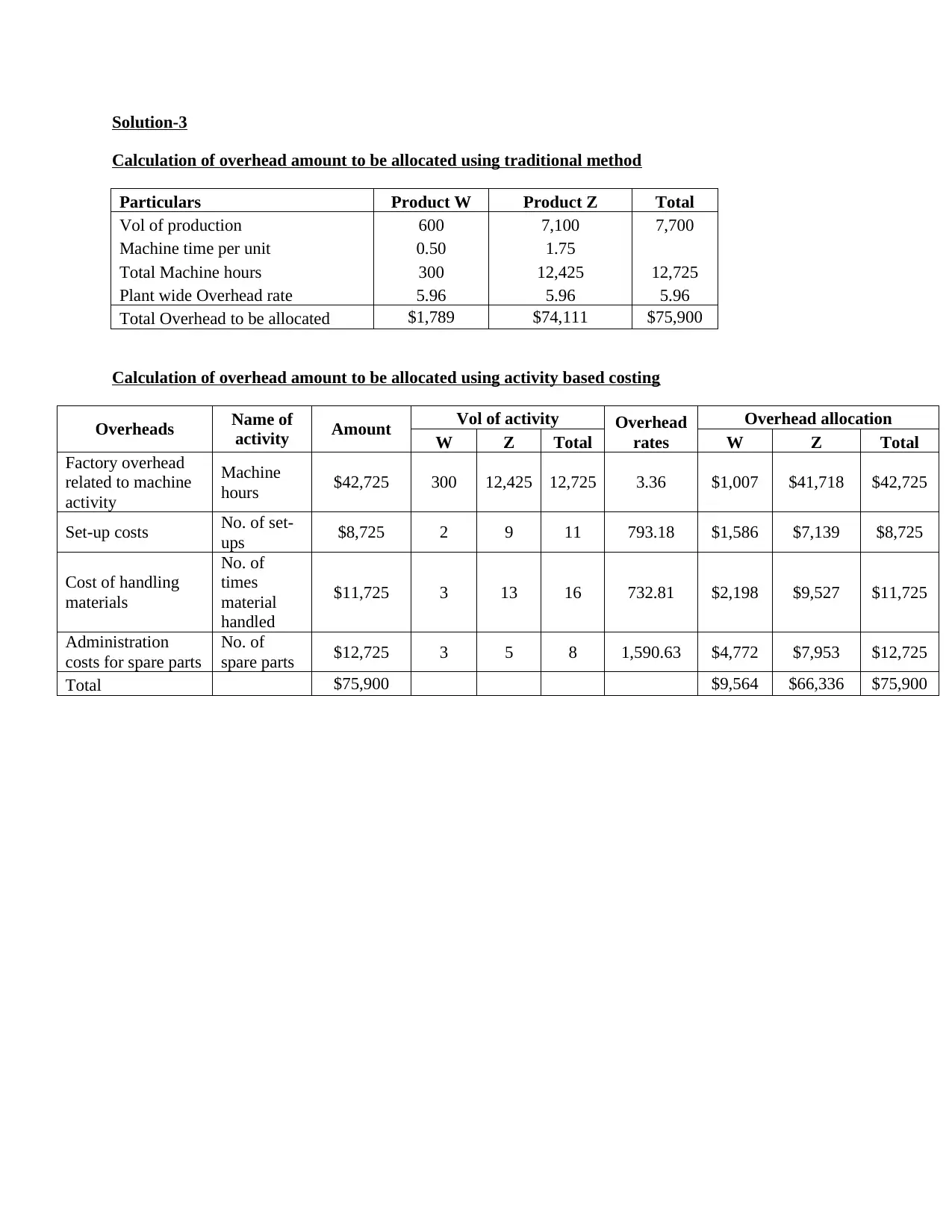
Solution-3
Calculation of overhead amount to be allocated using traditional method
Particulars Product W Product Z Total
Vol of production 600 7,100 7,700
Machine time per unit 0.50 1.75
Total Machine hours 300 12,425 12,725
Plant wide Overhead rate 5.96 5.96 5.96
Total Overhead to be allocated $1,789 $74,111 $75,900
Calculation of overhead amount to be allocated using activity based costing
Overheads Name of
activity Amount Vol of activity Overhead
rates
Overhead allocation
W Z Total W Z Total
Factory overhead
related to machine
activity
Machine
hours $42,725 300 12,425 12,725 3.36 $1,007 $41,718 $42,725
Set-up costs No. of set-
ups $8,725 2 9 11 793.18 $1,586 $7,139 $8,725
Cost of handling
materials
No. of
times
material
handled
$11,725 3 13 16 732.81 $2,198 $9,527 $11,725
Administration
costs for spare parts
No. of
spare parts $12,725 3 5 8 1,590.63 $4,772 $7,953 $12,725
Total $75,900 $9,564 $66,336 $75,900
Calculation of overhead amount to be allocated using traditional method
Particulars Product W Product Z Total
Vol of production 600 7,100 7,700
Machine time per unit 0.50 1.75
Total Machine hours 300 12,425 12,725
Plant wide Overhead rate 5.96 5.96 5.96
Total Overhead to be allocated $1,789 $74,111 $75,900
Calculation of overhead amount to be allocated using activity based costing
Overheads Name of
activity Amount Vol of activity Overhead
rates
Overhead allocation
W Z Total W Z Total
Factory overhead
related to machine
activity
Machine
hours $42,725 300 12,425 12,725 3.36 $1,007 $41,718 $42,725
Set-up costs No. of set-
ups $8,725 2 9 11 793.18 $1,586 $7,139 $8,725
Cost of handling
materials
No. of
times
material
handled
$11,725 3 13 16 732.81 $2,198 $9,527 $11,725
Administration
costs for spare parts
No. of
spare parts $12,725 3 5 8 1,590.63 $4,772 $7,953 $12,725
Total $75,900 $9,564 $66,336 $75,900
⊘ This is a preview!⊘
Do you want full access?
Subscribe today to unlock all pages.

Trusted by 1+ million students worldwide
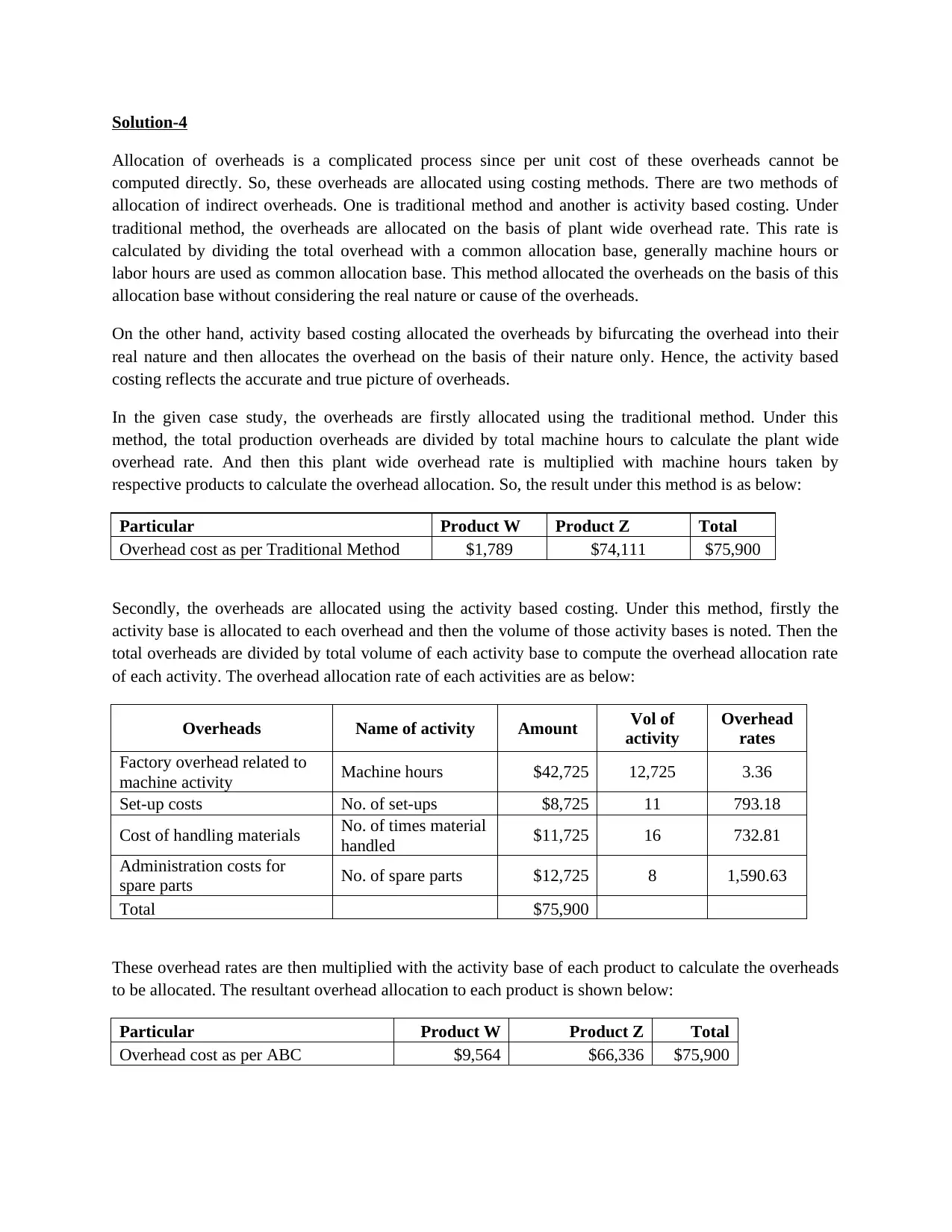
Solution-4
Allocation of overheads is a complicated process since per unit cost of these overheads cannot be
computed directly. So, these overheads are allocated using costing methods. There are two methods of
allocation of indirect overheads. One is traditional method and another is activity based costing. Under
traditional method, the overheads are allocated on the basis of plant wide overhead rate. This rate is
calculated by dividing the total overhead with a common allocation base, generally machine hours or
labor hours are used as common allocation base. This method allocated the overheads on the basis of this
allocation base without considering the real nature or cause of the overheads.
On the other hand, activity based costing allocated the overheads by bifurcating the overhead into their
real nature and then allocates the overhead on the basis of their nature only. Hence, the activity based
costing reflects the accurate and true picture of overheads.
In the given case study, the overheads are firstly allocated using the traditional method. Under this
method, the total production overheads are divided by total machine hours to calculate the plant wide
overhead rate. And then this plant wide overhead rate is multiplied with machine hours taken by
respective products to calculate the overhead allocation. So, the result under this method is as below:
Particular Product W Product Z Total
Overhead cost as per Traditional Method $1,789 $74,111 $75,900
Secondly, the overheads are allocated using the activity based costing. Under this method, firstly the
activity base is allocated to each overhead and then the volume of those activity bases is noted. Then the
total overheads are divided by total volume of each activity base to compute the overhead allocation rate
of each activity. The overhead allocation rate of each activities are as below:
Overheads Name of activity Amount Vol of
activity
Overhead
rates
Factory overhead related to
machine activity Machine hours $42,725 12,725 3.36
Set-up costs No. of set-ups $8,725 11 793.18
Cost of handling materials No. of times material
handled $11,725 16 732.81
Administration costs for
spare parts No. of spare parts $12,725 8 1,590.63
Total $75,900
These overhead rates are then multiplied with the activity base of each product to calculate the overheads
to be allocated. The resultant overhead allocation to each product is shown below:
Particular Product W Product Z Total
Overhead cost as per ABC $9,564 $66,336 $75,900
Allocation of overheads is a complicated process since per unit cost of these overheads cannot be
computed directly. So, these overheads are allocated using costing methods. There are two methods of
allocation of indirect overheads. One is traditional method and another is activity based costing. Under
traditional method, the overheads are allocated on the basis of plant wide overhead rate. This rate is
calculated by dividing the total overhead with a common allocation base, generally machine hours or
labor hours are used as common allocation base. This method allocated the overheads on the basis of this
allocation base without considering the real nature or cause of the overheads.
On the other hand, activity based costing allocated the overheads by bifurcating the overhead into their
real nature and then allocates the overhead on the basis of their nature only. Hence, the activity based
costing reflects the accurate and true picture of overheads.
In the given case study, the overheads are firstly allocated using the traditional method. Under this
method, the total production overheads are divided by total machine hours to calculate the plant wide
overhead rate. And then this plant wide overhead rate is multiplied with machine hours taken by
respective products to calculate the overhead allocation. So, the result under this method is as below:
Particular Product W Product Z Total
Overhead cost as per Traditional Method $1,789 $74,111 $75,900
Secondly, the overheads are allocated using the activity based costing. Under this method, firstly the
activity base is allocated to each overhead and then the volume of those activity bases is noted. Then the
total overheads are divided by total volume of each activity base to compute the overhead allocation rate
of each activity. The overhead allocation rate of each activities are as below:
Overheads Name of activity Amount Vol of
activity
Overhead
rates
Factory overhead related to
machine activity Machine hours $42,725 12,725 3.36
Set-up costs No. of set-ups $8,725 11 793.18
Cost of handling materials No. of times material
handled $11,725 16 732.81
Administration costs for
spare parts No. of spare parts $12,725 8 1,590.63
Total $75,900
These overhead rates are then multiplied with the activity base of each product to calculate the overheads
to be allocated. The resultant overhead allocation to each product is shown below:
Particular Product W Product Z Total
Overhead cost as per ABC $9,564 $66,336 $75,900
Paraphrase This Document
Need a fresh take? Get an instant paraphrase of this document with our AI Paraphraser
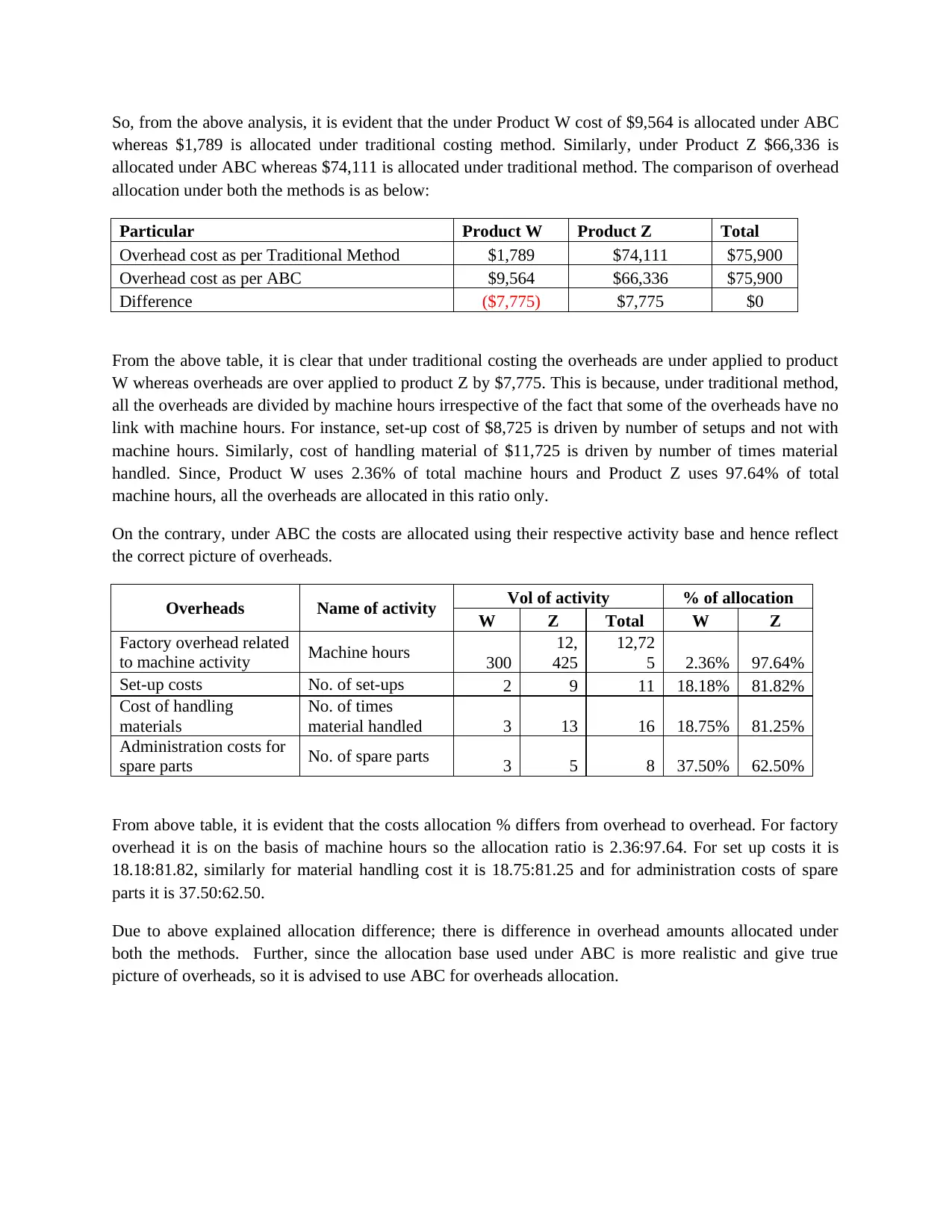
So, from the above analysis, it is evident that the under Product W cost of $9,564 is allocated under ABC
whereas $1,789 is allocated under traditional costing method. Similarly, under Product Z $66,336 is
allocated under ABC whereas $74,111 is allocated under traditional method. The comparison of overhead
allocation under both the methods is as below:
Particular Product W Product Z Total
Overhead cost as per Traditional Method $1,789 $74,111 $75,900
Overhead cost as per ABC $9,564 $66,336 $75,900
Difference ($7,775) $7,775 $0
From the above table, it is clear that under traditional costing the overheads are under applied to product
W whereas overheads are over applied to product Z by $7,775. This is because, under traditional method,
all the overheads are divided by machine hours irrespective of the fact that some of the overheads have no
link with machine hours. For instance, set-up cost of $8,725 is driven by number of setups and not with
machine hours. Similarly, cost of handling material of $11,725 is driven by number of times material
handled. Since, Product W uses 2.36% of total machine hours and Product Z uses 97.64% of total
machine hours, all the overheads are allocated in this ratio only.
On the contrary, under ABC the costs are allocated using their respective activity base and hence reflect
the correct picture of overheads.
Overheads Name of activity Vol of activity % of allocation
W Z Total W Z
Factory overhead related
to machine activity Machine hours 300
12,
425
12,72
5 2.36% 97.64%
Set-up costs No. of set-ups 2 9 11 18.18% 81.82%
Cost of handling
materials
No. of times
material handled 3 13 16 18.75% 81.25%
Administration costs for
spare parts No. of spare parts 3 5 8 37.50% 62.50%
From above table, it is evident that the costs allocation % differs from overhead to overhead. For factory
overhead it is on the basis of machine hours so the allocation ratio is 2.36:97.64. For set up costs it is
18.18:81.82, similarly for material handling cost it is 18.75:81.25 and for administration costs of spare
parts it is 37.50:62.50.
Due to above explained allocation difference; there is difference in overhead amounts allocated under
both the methods. Further, since the allocation base used under ABC is more realistic and give true
picture of overheads, so it is advised to use ABC for overheads allocation.
whereas $1,789 is allocated under traditional costing method. Similarly, under Product Z $66,336 is
allocated under ABC whereas $74,111 is allocated under traditional method. The comparison of overhead
allocation under both the methods is as below:
Particular Product W Product Z Total
Overhead cost as per Traditional Method $1,789 $74,111 $75,900
Overhead cost as per ABC $9,564 $66,336 $75,900
Difference ($7,775) $7,775 $0
From the above table, it is clear that under traditional costing the overheads are under applied to product
W whereas overheads are over applied to product Z by $7,775. This is because, under traditional method,
all the overheads are divided by machine hours irrespective of the fact that some of the overheads have no
link with machine hours. For instance, set-up cost of $8,725 is driven by number of setups and not with
machine hours. Similarly, cost of handling material of $11,725 is driven by number of times material
handled. Since, Product W uses 2.36% of total machine hours and Product Z uses 97.64% of total
machine hours, all the overheads are allocated in this ratio only.
On the contrary, under ABC the costs are allocated using their respective activity base and hence reflect
the correct picture of overheads.
Overheads Name of activity Vol of activity % of allocation
W Z Total W Z
Factory overhead related
to machine activity Machine hours 300
12,
425
12,72
5 2.36% 97.64%
Set-up costs No. of set-ups 2 9 11 18.18% 81.82%
Cost of handling
materials
No. of times
material handled 3 13 16 18.75% 81.25%
Administration costs for
spare parts No. of spare parts 3 5 8 37.50% 62.50%
From above table, it is evident that the costs allocation % differs from overhead to overhead. For factory
overhead it is on the basis of machine hours so the allocation ratio is 2.36:97.64. For set up costs it is
18.18:81.82, similarly for material handling cost it is 18.75:81.25 and for administration costs of spare
parts it is 37.50:62.50.
Due to above explained allocation difference; there is difference in overhead amounts allocated under
both the methods. Further, since the allocation base used under ABC is more realistic and give true
picture of overheads, so it is advised to use ABC for overheads allocation.
1 out of 5
Related Documents
Your All-in-One AI-Powered Toolkit for Academic Success.
+13062052269
info@desklib.com
Available 24*7 on WhatsApp / Email
![[object Object]](/_next/static/media/star-bottom.7253800d.svg)
Unlock your academic potential
Copyright © 2020–2025 A2Z Services. All Rights Reserved. Developed and managed by ZUCOL.





